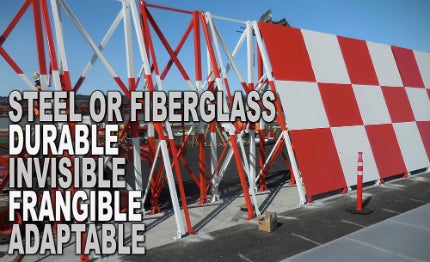
Blastwall engineers steel and fiberglass jet blast walls for the protection of buildings, navigation equipment, vehicle traffic, and ground personnel at airports worldwide.
The company’s jet blast deflector walls are uniquely designed in steel or radar-invisible fiberglass to meet the highest airport operator performance standards and budget constraints.
Durable and affordable steel, or radar-invisible fiberglass blast deflectors
Blastwall aims to solve a variety of technical challenges at airports, for example, Blastwall Fiberglass is a patented blast deflector product engineered in Canada and installed at major airports.
Its unique all-fiberglass structure creates no radar image and requires virtually no maintenance, making it ideal for even the most stringent site technical requirements.
Blastwall also designs and manufactures traditional steel jet blast deflector walls, applying the same precision and reliability found in the company’s fiberglass deflectors.
Whether you choose steel or all-fiberglass construction, Blastwall is a reliable and affordable choice for superior jet blast deflector technology.
Customisable, reliable and affordable jet blast fences for traditional applications
Blastwall has an accomplished history in the design and installation of all-steel jet blast deflector walls. Steel offers cost advantages and can be installed and maintained using well-established traditional methods.
Blastwall is renowned for producing and implementing traditional all-steel jet blast deflector walls for demanding airport operators worldwide.
Notable Blastwall installations include:
- San Francisco International Airport, US
- Queenstown Airport, New Zealand
- Chattrapati Shivaji Airport, Mumbai, India
- Pearson Airport, Toronto, Canada
- Midway Airport, Chicago, US
- Fort Dix US Army Base, New Jersey, US
- O’Hare Airport, Chicago, US
- Abbotsford Airport, British Columbia, Canada
- Pulkovo Airport, Saint Petersburg, Russia
Invisible, frangible and durable jet blast fences for specialised airport installations
Blastwall has engineered an all-fiberglass blast fence with the structural strength to withstand jet takeoff impact, while remaining invisible to radar and radio transmissions.
Blastwall Fiberglass provides many advantages over traditional airport wall structures made of steel, such as:
- Zero radar footprint – The performance of ground radar and radio beacons is unaffected as Blastwall’s frame and plating contain no steel components
- No corrosion – The all-fiberglass structure, plating, girders, and bolts offer a virtually indefinite operational lifetime, with almost zero requirements for maintenance
- No runway closures – Installation is by work crews without the need for cranes, which will block access to landing paths.
- Minimum site preparation – Levelling and placement of concrete mounting points with steel bolts at ground level is the only site preparation required
Safe, blast-resistant fiberglass engineering
Blastwall products are engineered to deflect blasts of 160km/h at a safety factor of 1.5:1, yet have sufficient frangibility to collapse upon impact without major damage to aircraft or to the Blastwall.
All components of Blastwall Fiberglass, including nuts and bolts, are made from pultruded or moulded fiberglass to create a lightweight and durable structure with no metal parts. Pigment and UV stabilisers are incorporated into the fiberglass resin to make it corrosion-resistant and maintenance-free.
Blastwall has been tested extensively by NAV Canada for non-interference performance during ground-based and in-flight electronic signal emissions. It has been engineered to meet or exceed NAV Canada airside installation requirements, and has been approved for installation in airports across Canada.
About Blastwall
The initial development of Blastwall Fiberglass, the unique radar-invisible jet blast deflector fence, was the result of a patented system developed by Blastwall.
The company’s first airport deployment was a project undertaken in 1998 between Blastwall Ltd, the Greater Toronto Airports Authority (GTAA), and NAV Canada.
In the years since that pioneering installation, Blastwall has engineered airport jet protection wall installations in many challenging locations and circumstances.
The Blastwall jet blast deflector fence continues to be engineered in Toronto, Canada and is manufactured in both Canada and the US.

















